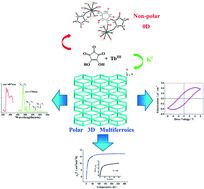Construction of multifunctional materials based on Tb3+ and croconic acid, directed by K+ cations: synthesis, structures, fluorescence, magnetic and ferroelectric behaviors†
Abstract
In order to obtain multifunctional molecular-based materials, especially multiferroics, a polar structure is essential. In this study, we find that intelligently using the K+ cation can effectively achieve this goal in the Tb3+-croconate hybrid system. Four rationally designed complexes based on Tb3+ and croconic acid have been synthesized and structurally characterized. The complexes have the formula [Tb2(C5O5)3(H2O)12]·2H2O (1), [KTb(C5O5)2(H2O)6]·1.5H2O (2), [Tb(C5O5)(Hdpa)(H2O)5]·H2O (3) and [KTb(C5O5)2(H2O)5]·2H2O (4), (H2C5O5 = croconic acid, H2dpa = 2,5-dipicolinic acid). The structures of the complexes were remarkably different after K+ was introduced. Complex 1, constructed by eight-coordinate Tb3+ nodes connected with C5O52− and H2O, is a novel 0D metal–organic architecture with abundant O–H⋯O hydrogen bonds, whereas complex 2 is a 1D chain built by C5O52− spacers bridging five-coordinate K+ and eight-coordinate Tb3+ ions. Complex 3 has deprotonated C5O52− and Hdpa− anions connected to an eight-coordinate Tb3+ center, to give a polar 0D structure. Complex 4, constructed by nine-coordinate Tb3+ and ten-coordinate K+ nodes connected with C5O52− and H2O, is a novel, polar 3D metal–organic architecture. The fluorescence spectra of 1–4 show characteristic emission bands of Tb3+ ions. Interestingly, the fluorescence intensities of complexes 3 and 4, especially emissions at 370 nm, are significantly enhanced compared to the intensities of 1 and 2, owing to the structural differences. Magnetic susceptibility studies of complexes 1–4 show similar patterns. Furthermore, complex 4 exhibits a ferroelectric hysteresis loop at room temperature, due to its polarity. Thus, in this work, by merely adjusting the polarity of the structure, a series of different, versatile compounds were obtained as potential multifunctional materials.


 Please wait while we load your content...
Please wait while we load your content...